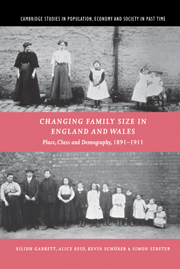Book contents
- Frontmatter
- Contents
- List of figures
- List of tables
- Preface and acknowledgements
- 1 Introduction
- 2 Locations for study
- 3 Studying locations
- 4 Infant and child mortality from the 1911 census
- 5 Fertility and fertility behaviour 1891–1911
- 6 The national picture
- 7 Class, place and demography: the mosaic of demographic change in England and Wales from Waterloo to the Great War
- Appendices
- References
- Index
- Cambridge Studies in Population, Economy and Society in Past Time
Preface and acknowledgements
Published online by Cambridge University Press: 05 January 2010
- Frontmatter
- Contents
- List of figures
- List of tables
- Preface and acknowledgements
- 1 Introduction
- 2 Locations for study
- 3 Studying locations
- 4 Infant and child mortality from the 1911 census
- 5 Fertility and fertility behaviour 1891–1911
- 6 The national picture
- 7 Class, place and demography: the mosaic of demographic change in England and Wales from Waterloo to the Great War
- Appendices
- References
- Index
- Cambridge Studies in Population, Economy and Society in Past Time
Summary
This book would not have been written had it not been for a meeting, in the mid-1980s, between Peter Laslett and Roger Thatcher, the then Registrar-General. Neither fertility nor the survival chances of young children was the original focus of their discussions, but their vision of comparative historical research across space and time made the present study possible.
The four authors came together from a diversity of academic disciplines; history, geography and demography, and this has encouraged us to take an interdisciplinary approach to our subject. Realisation that we were not always ‘talking the same language’ led us, within the constraints of the space available, to lay out the methods, techniques and assumptions used in an effort to make our work more transparent for readers drawn from across a spectrum of disciplines. Our book has been laid out in the expectation that readers may wish to go straight to chapters which interest them, but with the hope that they might feel drawn to follow cross-references to investigate more fully the interconnections between fertility and mortality, geography and history, sources and methods.
Our work, we gratefully acknowledge, has been supported throughout by funding from the Economic and Social Research Council (ESRC), and has formed part of the research programme of the Cambridge Group for the History of Population and Social Structure.
- Type
- Chapter
- Information
- Changing Family Size in England and WalesPlace, Class and Demography, 1891–1911, pp. xxi - xxivPublisher: Cambridge University PressPrint publication year: 2001

